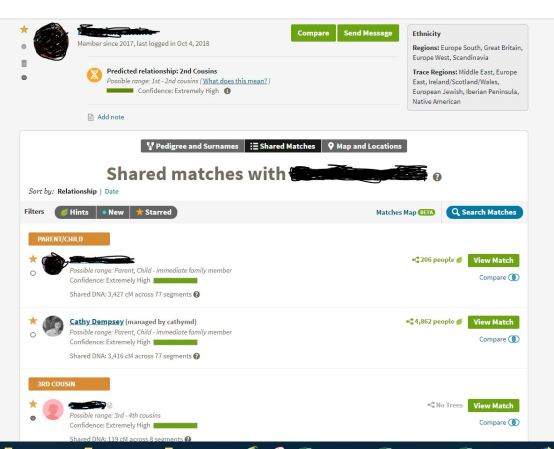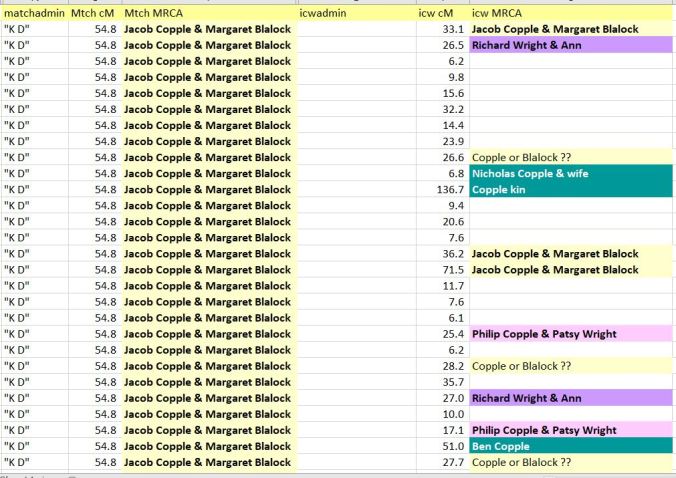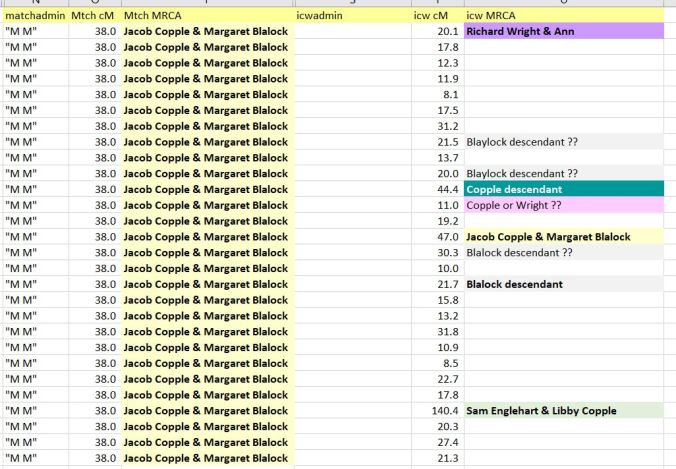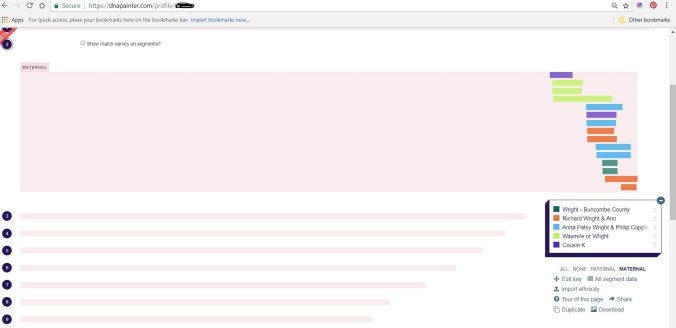Transcription of probated will of Richard Wright, Sr., my 7th-great grandfather.
From the office of Clerk Superior Court, Rowan County, Salisbury, North Carolina, in Will Book C, page 207. This particular copy is from “North Carolina Probate Records, 1735-1970,” digital images. FamilySearch (http://FamilySearch.org : accessed 2015) > imgs 158-159; citing County courthouses, North Carolina.
(transcribed by Cathy Dempsey 12/29/2015; bolding, italicization and brackets are mine)
“In the name of God Amen. I, Richard WRIGHT Senr. of the County of Rowan & State of North Carolina being through the abundant mercy and goodness of God tho weak in body Yet of a sound and perfect understanding & Memory do constitute this my last Will and Testament, and desire it may be Received by all as such as for my burial I desire it to be decent without pomp or State at the discretion of my dear Wife and as to my worldly Estate I will and positively order that all my debts be paid. I give and bequeath to my son Benjamin Two hundred Acres of land lying on the Waters of deep River in Randolph County, Including the plantation whereon he used to live & I give to my son Peter Twenty Shillings & I give to my Sons Richard & William an Entry of land containing 226 Acres lying in Randolph County on the Waters of Uary to be divided equally at their own discretion. I give to my son Amus One hundred Acres of land including the house wherein he now lives & the price of a new Saddle and Bridle & I likewise give to my son William a feather Bed and furniture & and I give to my son Evins a milch cow a feather bed and furniture and the price of a good saddle and Bridle. [This line bequeathing Evans is included in the copy existing at NC Archives, but NOT in the copy which Familysearch.org has.] I give to my son John a cow and Calf or the Value thereof in Gold or Silver & I give to my son Philburd a Horse Bridle and Saddle and a Cow and feather Bed and furniture at the age of Twenty One or at his Mothers discretion and this plantation where I now live at his Mothers decease or Marriage and I give to my dear and loving Wife Two hundred Acres of land lying on deep River where I formerly used to live in Randolph County to sell at her discretion and likewise all my moveable property that I possess and if she Marrys two thirds of the Estate is to be divided equal amongst the Children and if she dies without marrying the prinsable [principal] Estate is to be divided equal amongst the all my Children. In witness whereof I have hereunto set my hand and seal this third day of September; Anno Dom: 1784
Witness present
Wm X Wright His Mark Richard R WRIGHT (Seal) His Mark
Evins X Wright His Mark
Richard Wright
James MORGAN Junr.
Questions 12/29/2015
Benjamin is given 200 acres near Deep River in Randolph County – when does he sell or bequeath this land? He dies in Marion County, Indiana, so there should be a deed transferring the land to a child, or a will, or a sale to someone else.
Why does Peter only get 20 shillings?
Note on 23 Sep 2019: On 29 Jul 1783 Richard Wright assigned to “my son Peter” one of his own land grants for 200 acres.[1]
[1]“North Carolina, Land Grant Files, 1693–1960,” database with images, Ancestry (https://www.ancestry.com : accessed 23 Sept 2019) > Randolph > 1-257 > image 1141 of 1343.
226 acres goes to Richard C Wright and his brother William. What happens to this land? Richard remains in the area to the end of his life, and Richard ends up living in Davidson County (formed from Rowan in 1822). So to whom does he sell his share of the 226 acres? What about William?
Note on 23 Sep 2019: 226 acres of land in Randolph County is assigned to William Summers (a possible brother of Rebecca Summers, who married Evans Wright, one of Richard’s sons) by William Wright in 1787. Could this be the same land as above? See: https://www.ancestry.com/interactive/60621/44173_355605-00907/81611?
Amos is living on 100 acres at the time of the will, which is bequeathed him by his father. Where is he living? In Rowan? Or in Randolph?
Richard’s wife gets 200 acres of Richard’s land in Randolph County where he used to live. Which land is that? Is it part of the 400 acres he used to have by Deep River? When is it sold or transferred to other members of the family? Does Richard’s wife have a will after he dies?
Richard’s son Philburd is given the land where Richard and his wife are currently living (in 1784) when Richard’s wife dies or remarries. When does Philburd get this land, and what happens to it in the future? [check Rowan County indexes for Philburd Wright grantee and grantor. He would turn 21 in 1789.]
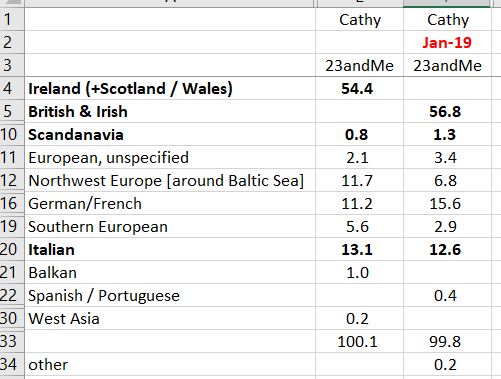

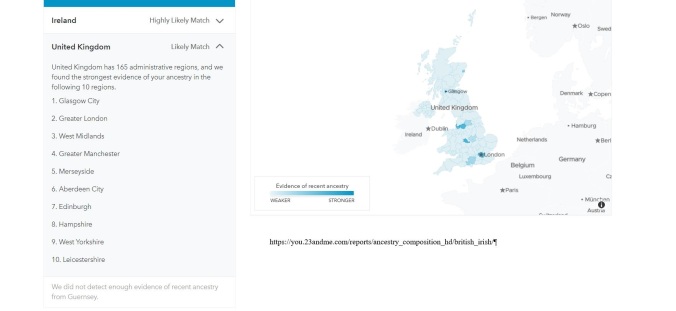 Perhaps these areas could be clues, but it would be silly to jump ahead of myself and start researching Wrights and Lamburth/Lamberts over in England without knowing more about the family here in the U.S. in the 18th century. The references to Scotland surprise me a bit, but could be related to the Gaelic / Celtic heritage of my Irish side.
Perhaps these areas could be clues, but it would be silly to jump ahead of myself and start researching Wrights and Lamburth/Lamberts over in England without knowing more about the family here in the U.S. in the 18th century. The references to Scotland surprise me a bit, but could be related to the Gaelic / Celtic heritage of my Irish side.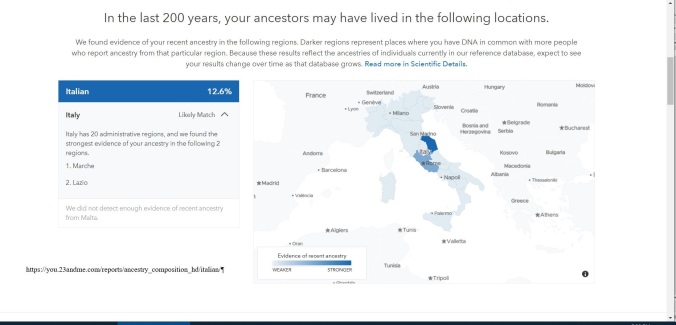 Pretty wild, huh? Marche!! Still have to take it with a grain of salt – my brother’s estimated places of origin in Italy are completely different from mine – but still, right now, today, it “fits”.
Pretty wild, huh? Marche!! Still have to take it with a grain of salt – my brother’s estimated places of origin in Italy are completely different from mine – but still, right now, today, it “fits”.
